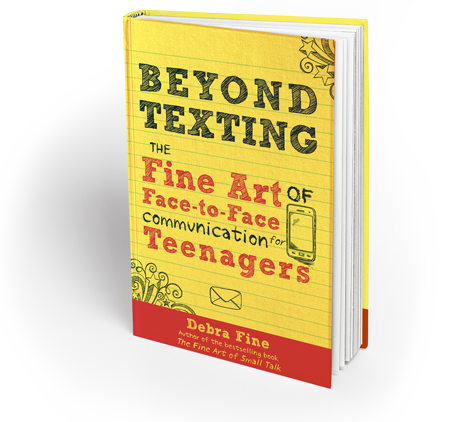
Beyond Texting is the first book for teens to explain how to be plugged in without neglecting the necessity and power of physical, human interaction. Even the most outgoing teen may find a job interview, first date or meeting with a teacher to be challenging because of lack of skill. Offering practical advice and cheat sheets Beyond Texting strives to help teens balance their digital and real world image and relationships. This book is for the teenager who wants to learn to:
- Prepare for face-to-face teacher meetings, dates, interviews and school events
- Build social opportunities without the use of social networking sites
- Avoid conversational “faux pas”
- Become aware of the importance of body language, eye contact and tone
- Recognize when your online involvement is interfering with your offline existence
- Interact with authority figures and an older, less technology-savvy generation
- Eliminate the trauma of false friendships and bullying
Written by Debra Fine, author of the bestselling books… The Fine Art of Small Talk: How to Start a Conversation, Keep It Going, Build Networking Skills – and Leave a Positive Impression! and The Fine Art of the Big Talk: How to Win Clients, Deliver Great Presentations, and Solve Conflicts at Work translated and published in over 20 countries. Debra travels the globe as keynote speaker and communication expert teaching conversation skills and networking techniques to organizations that include Google, Deloitte, the National Association of School Boards and the University of Chicago Booth Graduate School of Business.
Editorial Reviews
From School Library Journal
“Gr 7 Up—Fine, who has written titles for adults, now turns to teens with advice on conversation and social skills to help with friendship, jobs, and social events. Short chapters use pithy titles to describe various topics (“Entering the Chatroom” discusses icebreakers, while “Sending Instant Messages” deals with body language) and, in a nod to Facebook, end with a “poke,” or a brief sum-up. Unfortunately, these metaphors feel a bit forced and may date quickly. The book is divided into three sections: “Conquering the Conversational Basics,” “Dealing with Difficult Interactions,” and “Managing the Digital World.” The first section is the most successful and contains some helpful suggestions for starting a conversation that both adults and teens should find beneficial, while the latter two have some fairly predictable advice without real insight. Overall, the author’s style is accessible to teens. A useful book, but one that may have limited appeal to its intended audience.”
— Michelle Anderson, Tauranga City Libraries, New Zealand
Publishers Weekly
“Fine aims to help teenagers navigate their social and professional lives through effective communication. Suggesting that early relationships inform later ones, she encourages readers to move beyond their comfort zones to better understand themselves and others. Included are anecdotes about individuals facing various dilemmas (one student “comes across as disengaged in class” because she is shy and avoids eye contact with her teacher), as well as tips for making conversation, saying “no” to peer pressure, and balancing online and in-person relationships. Fine is keenly aware of the role technology plays in teenage relationships, while recognizing that building meaningful connections still requires work”
— Publishers Weekly
Booklist, (Reprinted with permission of Booklist, copyright 2014, American Library Association.)
“This how-to-communicate guidebook offers young readers active tips for putting forward their best selves clearly and accessibly in all manner of social situations. From basics such as breaking the ice, keeping a conversation humming, and speaking with adults to more advanced topics making romantic connections, handling confrontation, dealing with cyber bullying, and integrating digital and in-person interactions, this slim volume offers a wealth of information. Fine cleverly draws comparisons between digital spheres and in-person interactions, and she helpfully offers suggestions for moving from virtual conversations to IRL (in real life) with a special exhortation to be careful when meeting online friends in person for the first time. While the advice for teens is handy, this may find a wider readership among adults who want to impart good advice to teens or better understand electronic communication. Though the block like paragraphs and sparse illustrations are less likely to appeal to the social media savvy, the advice calling for direct, honest, respectful, and confident in-person conversations are certainly valuable.”
Buy it today!
 A Message from the Author
A Message from the Author
As a parent of now adult children, raising them I was reminded of the social challenges so many of us experienced during our own teen years. Especially communication challenges. Overcoming shyness was a big one for me. Making friends was a constant pursuit, interacting with authority figures caused great nervousness, and attending a meeting or joining a group alone was out of the question. With the advent of texting and social media, face-to-face communication for teenagers is not as necessary or common experience. How does a teenager fare when texting is not an option? My passion is to offer conversation tools and tips to not only teens but equally important the leaders in their lives. This extends from parents and teachers, to leaders in our religious institutions, scouting programs, sororities/ fraternities, camp counselors and all kinds of mentors to young people.







